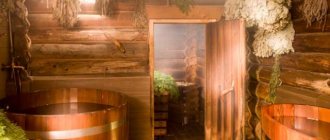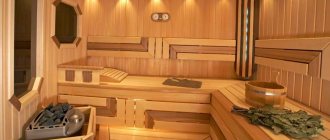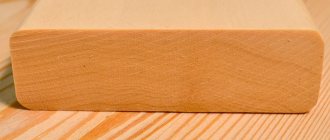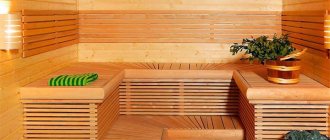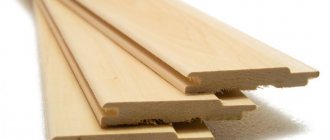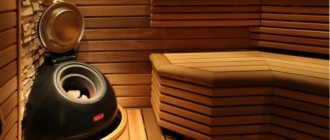Peculiarities
Linden has technical characteristics comparable to aspen. It belongs to hardwood and has a uniform density. The raw material does not retain its geometry when dried. It may crack and warp.
Linden dried to a moisture content of 6-10% becomes stable, so only dry finishing material is used to decorate the bathhouse.
Density of dry material – 495 kg/m3. The wood may be white, pale yellow, light brown or pinkish in color. In order to give a white linden a yellowish tint, it is enough to hold it in the sun for a short time. The treated wood surface has a moderate natural shine.
Knots and other defects are rarely found in the smooth texture of linden. The material has low wear resistance. This property allows it to be bent and polished without consequences. The strength of linden dried to a moisture content of no more than 15% for compression along the fibers is 39 MPa and for bending 68 MPa. The specific gravity of dry wood is 0.53 g/cm3.
Pros and cons compared to other breeds
But in order to understand something, you need to compare it with alternative options. Since it is preferable to sheathe a steam room with deciduous wood, most people will call aspen an alternative to linden. So let’s look at the comparative merits of linden or aspen in a bathhouse. And one more - a little less common - comparison of linden or alder for a bathhouse - which is better?
Which is better: linden or aspen?
So here's the table:
From the columns that show the coefficients of shrinkage and swelling, that is, the change in dimensions under the influence of humidification and loss of moisture, we see that aspen is better than linden for a bathhouse. Although the difference here is not so great as to call aspen a clear favorite.
Because it darkens in the bathhouse faster than linden. Otherwise, their properties are very similar. Even if other sources give slightly different densities, they are still fairly close to each other.
Aspen darkens from water
In the store, linden will cost more than aspen, but also not by much. Therefore, go through your priorities - you will have to look for high-quality aspen wood and spend your time on it. If you are ready for this, bet on aspen, and linden will remain for those who prefer the option that is not much worse, but faster, albeit more expensive.
IMPORTANT! In a bathhouse, any(!) wood rots, only the conditions and timing vary. If you feel dry after the procedures (see
section on ventilation), then linden will last longer than larch for someone who neglects drying.
And so, of course, linden is practically unable to resist rotting, unless you help it with impregnations. But this also applies to aspen. Yes, it gains hardness under the influence of water, but its resistance to rotting is low.
In general, these two species have very similar characteristics, we recommend aspen, but if you have problems with a good aspen or you just like linden, take it.
Linden or alder?
But of this pair, we prefer linden. Alder is best at the harvesting stage, because linden is often discarded during the initial drying - this is when its warping occurs. Dried linden is quite stable and does not create problems. Alder exhibits minimal warping even at the initial drying stage.
But if you are an ordinary buyer, then it is enough to check the moisture content of the purchased lumber and the presence of warping - any differences from the correct geometry, for example, bends or twists.
Otherwise, these are also two types of wood quite similar to each other. Alder is as inelastic, soft, easy to work with and not resistant to rotting as linden.
ATTENTION! Alder and linden are damaged by metal-wood contact in a humid environment. Therefore, it is advisable to protect screw fastenings from moisture, or abandon them in favor of classic carpentry joints
If you have a choice, then from black and gray alder you should choose black, it has better technical characteristics.
What else could be the basis for choice - alder has reddish shades and looks darker than linden. If you are interested in achieving just such an effect, you can use alder wood. Linden is lighter in color and yellow, but there are pinkish and reddish varieties. Linden smells nice, but the smell is weak. Alder is neutral.
As you can see, it all depends on personal preferences, and there are no significant disadvantages or advantages in either breed.
IMPORTANT! Please note that for now we are talking exclusively about wood for the steam room. If there is a desire to use any of the mentioned breeds outside of it, the chances of durability are increased due to the ability to use antiseptics
Application of linden
The material is widely used in interior decoration. Most often, lining made from it, imitation timber and block house are used for these purposes. Recently, the popularity of wall parquet has been growing. This type of material is used for finishing bath walls and ceilings. Less often, edged and unedged linden boards are used.
Linden is ideal for styling antique rooms. In addition to finishing materials, furniture and decorative elements made from this type of wood are widely used in the bathhouse.
Experts recommend making the entire interior trim from linden only in small-sized baths. In large-area baths, combined finishing is used.
Wall parquet
We can say that wall parquet is a type of lining for walls. To lay linden parquet, a lathing is used, to which parts of the wall parquet must be attached. Most often, bathhouses are arranged this way.
However, wall parquet has also found application in everyday life. To style houses as antique, as well as to create environmentally friendly apartments, parquet is used to cover the walls of literally any room, including corridors, kitchens and balconies.
The installation method resembles brickwork. The length of one element, most often, with a stable width and thickness, ranges from 15-20 centimeters to a meter. Using linden wall parquet, you can hide significant wall imperfections (unevenness, fungal damage), while creating a cozy and environmentally friendly room. Installation is quick and simple, the appearance is stylish, and the price is usually reasonable. Rating 5.
How does he behave in the bathhouse?
Dried wood can withstand temperature changes typical for a bathhouse. The finishing material made from it is not chemically active. Unlike conifers, when heated, it does not emit harmful substances that can cause toxic poisoning in humans. It does not crack or deform.
The high density of the material helps it dry quickly after getting wet. Linden does not absorb heat from the heated air of the steam room, so it does not heat up too much and it is impossible to get burned on it. When heated, linden releases a medicinal aroma into the steam room. It has a relaxing effect on a person.
Experts recommend that if there is no linden finish in the bathhouse, use products or decorative elements made from this wood. Wood is not of interest to rodents, but after 6-8 years of use it must be replaced. This is due to the fact that linden is prone to rotting and quickly darkens.
Important! A bathhouse trimmed with linden must have a high-quality ventilation system.
Each time after taking a bath, it must be well ventilated. In a poorly dried room, linden becomes covered with fungus, which is very difficult to remove. The problem is complicated by the fact that the process of decay of the material begins from the inside and cannot be detected immediately.
In the bathhouse, linden material is used for cladding walls, ceilings and canopies. It is better to make floors from larch.
Comparative characteristics and selection of materials for finishing the bath
Knowing the general characteristics of the material, before ordering the material, it is worth carefully comparing linden and aspen as the main material for the log house and for the interior decoration of the steam room.
For a log bathhouse
For a real Russian bathhouse and Finnish sauna, a log house is an ideal building design option. The wooden frame not only has high structural qualities, but also provides better heat retention. Wood warms up faster, retains heat longer and is not subject to deformation due to temperature changes. A wooden frame reacts more easily to external factors, such as humidity and temperature fluctuations.
However, when choosing a material, it should be taken into account that when building a bathhouse from logs, the frame will shrink, and this will require additional costs for insulation. Today, for the construction of baths, ready-made sets of materials that have been pre-processed are mainly used. Rounded logs or beams are used for the bathhouse. Linden or aspen in the form of pure, solid timber or solid wood is rarely used today. Basically it is laminated veneer lumber, made from natural wood. Wood manufacturing and processing technology today allows manufacturers to talk about a 25 and even 50 year guarantee of the integrity of the material.
Log house for a bath made of aspen
But when it comes to a solid wood frame, it’s worth remembering:
- Aspen for a log house is taken at an age of 50-70 years, while linden must be at least 100 years old;
- Aspen does not require lengthy and expensive processing, while linden requires careful selection, removal of affected knots, and additional antiseptic treatment;
- An aspen log house can be erected entirely; the tree is not afraid of moisture, and is more durable for outdoor use.
- When building a log house, linden necessarily needs reliable waterproofing (that is why the lower crown of a linden bathhouse is built from oak);
- An aspen log house will cost 25-30% less than a linden log house, due to the low cost of the material.
For finishing the steam room
When the question of finishing a steam room and making beds arises, the situation here is somewhat different. When comparing aspen and linden, you need to remember that lining is mainly used for finishing. A board with a selected groove on one side and a tenon for such a groove on the other. The thickness of the lining, the length of the planks, and the width play a secondary role here and are mentioned mainly when calculating parameters at the project development stage. But consumer qualities need to be compared in more detail.
The pleasant white color of the wood, good structure, absence of knots and low price often become the determining factors when choosing aspen lining. Indeed, professionals advise purchasing aspen lining for finishing a steam room. This is optimal both for a steam room with intensive use and for a room in which people steam from time to time. Over time, wood acquires increased strength, which also has an excellent effect on the performance of the material. But as for the shortcomings, here it is worth remembering the specific smell of the material; of course, it will go away over time, but at first the bitter aroma will be clearly audible.
The structure of linden lining is much nicer than that of aspen. The lightness and warm shade of the wood itself make this material a favorite for finishing a steam room. Linden wood has low thermal conductivity; the steam room warms up faster and retains heat. The wood itself is devoid of any odor and therefore is excellent for finishing a steam room. At the same time, it is worth remembering that linden, unlike aspen, quickly loses its natural color and becomes darker. This is noticeable in the steam room, where an oak broom is used - tannins with steam eat into the fibers and change the color to deep brown.
Linden for finishing the steam room
On the other hand, linden lining is practically not subject to warping; it retains its original shape for a long time. During repeated heating and cooling cycles of the room, linden does not swell, which means fasteners, nails, and screws will remain in place.
When finishing a steam room, it is not recommended to use linden lining to the very bottom; unlike aspen, linden is susceptible to rotting, especially if the steam room is constantly saturated with steam. Therefore, during construction, it is recommended to tile 10-15 cm from the floor, and cover everything higher with clapboard.
For the dressing room and rest room
To decorate the dressing room and rest room, the lining is selected taking into account the fact that the temperature in the room will be significantly lower than in the steam room. Many even install pine lining in these rooms. Perhaps there is a reason for this, because pine has an interesting structure, and in terms of cost it is one of the most affordable materials. But if we are talking about an individual bath, then professionals advise not to consider any other materials other than aspen or linden.
Firstly, the costs of decorating the dressing room and rest room are not so large as to save. Secondly, the atmosphere of both the dressing room and the resting place is just as important for well-being as the atmosphere of the steam room. Thirdly, from a technical point of view, it is not rational to use other types of wood for finishing.
Why is it not rational to use other types of wood for finishing the dressing room? Everything is very simple. This room often houses a shower, bucket-waterfall, pool or plunge pool. Splashes of water and increased dampness at lower air temperatures contribute to the rapid development of fungal infections of the tree. And if pine with varnish or other special coating will last only a year or two, then for aspen lining a period of 10 years is not terrible. This will be especially visible near the entrance to the steam room, where the wood will begin to deteriorate most quickly.
For the relaxation room, where time will be spent between visits to the steam room, it is necessary to create comfortable conditions. And for this, the lining for a bath should be natural, without paint or varnish, the wood should be enveloped in the smell of wood, and not exude the smell of paint.
Interior decoration
The best option for finishing the interior of a bathhouse is lining.
3 types of profiles of this finishing material are made from linden:
eurolining (products with grooves on the reverse side and a compensation shelf at the joint);
softline (eurolining with rounded edges);
calm (planed panel with a semicircular chamfer).
The most widely used profile in bathhouse finishing is eurolining. It has optimal thickness and width, and can have different lengths, which contributes to economical consumption of material during finishing. Installation of eurolining is carried out on a wooden frame specially constructed for this purpose. It is made from guide bars with a cross section of 50x50 mm or 40x50 mm, which are attached to the walls.
The frame cells are filled with heat-insulating material. For these purposes, you can use “Rockwool Light Bats”. Aluminum foil for Teraspan saunas with a thickness of at least 100 microns is placed on it.
Slats with a cross section of 20x50 mm or 30x50 mm are fixed on top of the foil. The distance between adjacent slats is from 40 to 60 cm.
Important! The bars should be installed when installing the frame perpendicular to the planned location on the lining walls.
The profile is attached to the slats using clamps.
This is a special hidden fastener, thanks to which the profile can be easily removed during dismantling and does not have to be broken. The same method of installing lining is used for lining the ceiling in bathhouses. It is better to purchase thermolip for finishing a bath. This is material dried to a moisture content of 6-12%. It is resistant to rotting and does not change its geometric shape when exposed to temperatures and moisture.
Installing a canopy in a steam room
Linden is ideal for arranging multi-tiered wooden benches, which are convenient to place in a steam room. They should be free of knots, have a surface that is pleasant to the touch, and not heat up too much so as not to cause a burn to the human body. Linden meets these requirements in full.
This tree has hypoallergenic properties, under the influence of steam it releases phytoncides into the air that have medicinal properties, has a smooth surface without knots and a pleasant texture. The frame for the canopy can be made to reduce the cost of the structure from a coniferous bar with a cross-section of 50x70 mm. It consists of 3-5 support posts and cross members.
For waterproofing, rubber gaskets are installed at the ends of the racks. The canopy boards are fastened with self-tapping screws from inside the frame so that the metal caps do not burn a person when they are heated in the steam room. A gap of 1-2 cm wide is left between the canopy boards for water drainage.
To improve the performance characteristics of the canopy and increase its service life, the linden is coated with a layer of heat-resistant wax such as “GNature 290 Hartwachs”. It can also be used to treat walls and ceilings lined with linden material. A coating of two layers of wax lasts for about a year.
To install a canopy in a steam room, a rounded profile of category “A” or “B” is used, having a length of 1 to 3 meters. The optimal width of the boards is 90-92 mm, and the thickness is 26-28 mm.
Doors and windows
Linden doors are most often installed only in the steam room. Due to their low thermal conductivity, they retain heat well in the room. Properly processed material cannot be deformed. A linden door leaf can consist of either a vertical or horizontal profile. They make the door to the steam room only one-leaf.
Linden windows are rarely installed in bathhouses. Most often these are small windows in the steam room. To extend the life of wood, it is coated with antiseptics, fire retardants, oil or wax impregnations. Linden windows, due to the porosity of the material, are capable of letting air through and creating natural ventilation in the bathhouse.
Which wood is better to build a bathhouse from - the pros and cons of different species
Our grandfathers noted in advance the trees for their bathhouse. They were cut in winter, when the wood has the lowest percentage of moisture. Such a log house practically does not shrink, and cracking of the walls will be minimal. But even carefully selected trees must meet a number of characteristics:
- Have increased resistance to moisture.
- Durability.
- Do not carry negative energy.
Let's figure out what features different types have, pros, cons of log houses in the form of a table:
You can assemble a sauna frame from any wood. But for economy, pine wood is more often used. Pine and spruce are available in any region of Russia, but the high resin content does not make it possible to use them for interior decoration of a bathhouse. When heated, the walls and ceiling will begin to release resin, which can cause discomfort during procedures.
Expensive aspen, cedar and larch are optimal for building a log bathhouse. They tolerate moisture well and do not lose their quality characteristics over time. Saunas made of cedar and larch emit antiseptic vapors, and inside the steam room there will be a subtle and healing aroma. But it is not suitable for everyone, so we recommend that before construction you check whether the smell of wood will irritate family members. The price of the material is high and does not allow it to be used for construction.
Larch and aspen are mainly used as the lower crown of a log house. Over the years, the wood becomes stronger, and the bathhouse will last longer.
Linden and birch are available for construction, but we do not recommend building a log house from them. The steam room will not last long and will require repairs within a year.
Why are sauna logs rarely made from linden?
Despite the fact that linden is considered an ideal tree for a bathhouse, log houses are made from it extremely rarely. The reason for this is the high cost of wood and its fragility. Linden buildings maintain a good microclimate and a pleasant honey aroma is felt, which repels rodents from the structure.
Making baths from linden was common in Rus'. Peter I had such a bathhouse made from a simple solid linden tree. The advantages of linden log houses include the rare occurrence of cracks in the material and the minimum percentage of its shrinkage. The linden structure is lightweight, which reduces the requirements for foundation construction. It is easy to retain heat in it.
Other advantages of the material include:
- Medicinal properties of wood. The substances it releases into the air help cope with colds, cellulite and prevent liver diseases.
- The material is easily amenable to all types of processing.
- The fibers have a low density, which allows the wood to “breathe”.
Expert opinion
Lovkachev Boris Petrovich
Bath master who knows everything about steaming
All these advantages are offset by serious disadvantages. The lack of resin in linden wood causes increased interest in it from tree pests. Linden log houses require frequent treatment with antiseptics and are subject to rapid rotting in regions with a humid climate.
All this forces lovers of linden bathhouses to limit themselves only to interior decoration from it, and make log houses from other types of trees.
Which blocks are best to build a bathhouse from: the pros and cons of walls made of cinder blocks and foam blocks
To build walls from blocks, work needs to start from the corner of the future building. To bind individual elements, a cement-sand mortar is used, to which lime is added. In the first row, special pockets are provided into which floor beams are subsequently mounted.
When laying the second row, it is necessary to bandage: move the blocks by half their length to prevent the appearance of cracks when the building shrinks. For greater strength of the walls, reinforcing mesh is laid every 2 rows of building blocks.
At the top of window and door openings, place concrete slabs 60 cm longer than the width of the opening. In the last row there must be pockets for the ceiling beams.
The outside walls are covered with a heat-insulating layer and lined with brick. To securely secure the beams in the pockets, you can use metal corners. If voids form after fastening, they are filled with mineral wool.
Which blocks are best to build a bathhouse from - there is no definite answer. Cinder block baths have pros and cons, just as buildings made from foam blocks have their advantages and disadvantages.
The advantages of cinder blocks are that it is possible to produce blocks of different sizes for each specific case, they are resistant to mold, mildew, do not rot and have good fireproof characteristics.
The disadvantages of cinder blocks are poor sound insulation, high thermal conductivity (it is necessary to additionally heat the bathhouse during the washing process).
The advantages of foam blocks are fire resistance, ease of storage, installation and transportation, as well as low cost.
How to distinguish it from aspen?
It is difficult for an ordinary person to distinguish one type of wood from another.
Most often, linden is confused with aspen. Both types of trees are considered ideal for a bathhouse, but have a serious difference in cost. Aspen is much more expensive than pine needles, and linden is more expensive than aspen. Unlike linden, which can have various shades from white to coffee, aspen stands out for its snow-white surface.
Linden exudes a characteristic sweetish aroma, and aspen exudes a bitter odor reminiscent of birch sap. If the surface of linden becomes silky after processing, then a slight roughness may be felt on aspen. There are also dark falling knots on the surface of aspen.
An alternative to linden and lining made from it
Everyone loves linden lining, but is there an alternative? Or, as usual, unfounded laurels are sung to her. To do this, let's make a small comparison with other common materials. Let's take as a basis the popular theses about the benefits of linden.
- The low density of linden wood allows it not to burn the skin. The average density of linden is 495-530 kg/m3, for comparison: aspen - 495-520, cedar - 490-500, pine - 495-510, spruce - 400-450, larch - 660, alder - 490-520. That is, we see that in terms of density, the tree species that are used when building a bathhouse are very similar.
- Low thermal conductivity of linden: linden – 150 mW/(m*K), pine – 150, fir – 150, spruce – 110, cedar – 95, larch – 130.
- Resin release: linden, aspen, alder - no resin, pine, cedar spruce, larch - there is resin.
- The presence of essential oils that give aroma in the steam room and are released with greater heating. Here, as they say, it’s not an acquired taste. The smell of coniferous trees is approximately the same, but cedar is rightfully considered the best, and among deciduous trees, alder and aspen are slightly bitter.
- In terms of the “whiteness” of wood, only aspen can be compared with linden, but it tends to turn blue in humid conditions (just like linden, the room needs to be dried out).
- Wood lends itself well to processing. Here, only aspen and alder can compare with linden, that is, these are soft deciduous species. They make excellent lining with a “soft line” profile, but it is quite difficult to make “soft line” of the “extra” grade from conifers. As a rule, lining options with beveled rather than rounded chamfers are made from coniferous species (except for larch)
- Resistance to changes in temperature and humidity. Deciduous species will lead here, followed by larch, while pine, cedar and spruce have a very high risk of cracking.
Thus, we see that some of the benefits are, to put it mildly, exaggerated. In terms of density, linden does not differ from its main competitors. Its main advantage is its resistance to temperature and humidity changes, as well as high quality processing.
Recommendations for processing
The surface of the finishing material is covered with various means to protect it from environmental influences and insects, as well as for decorative purposes. Properly treated linden can last in a bathhouse for up to 100 years.
Modern manufacturers produce a wide range of products that can be safely used for treating wood in a bathhouse.
The most popular among them are:
ship varnish
linseed oil
wax mastics
Steam room products must have natural compositions, water or oil base.
Varieties
The differences between individual types of aspen wood are due to:
- humidity level in the growing region;
- perfection of processing;
- varieties;
- quantities of products.
Russian lining differs from foreign products in that it does not have elongated grooves at the back, which provide ventilation and relief from condensation. The increase in ridges and grooves to 0.8 cm, characteristic of eurolining, helps reduce the risk of cracks under the influence of high temperature and humidity, thereby increasing the strength of the joints. At the end of the work, European lining is sorted and packed in a special film (usually 10 pieces per package).
The “Extra” grade is considered the highest; to comply with it, the lining must not have a single defect or even a knot. The characteristics of the “Extra” grade make it possible to form any wooden structures, and they will be aesthetically perfect. In group A, the standards allow for the presence of knots and a difference in color from the usual color, but the mechanical and consumer properties are also quite good.
Grade B occupies an intermediate position between the main types A and C, it is relatively good and sells for relatively little money. Category B includes second grade wood, a certain number of jagged and knotty areas are allowed on the surfaces of the boards. Cracks are sometimes acceptable; knots should not fall out, but they can still cause accelerated damage to the lining.
Grade C has extremely low requirements for raw materials - such wood may contain signs of decomposition and rot, a number of cracks and jagged areas, areas that are clearly abnormal in color. Such solutions are not used in finishing; the only use is tools and equipment for work.
Thermal aspen (that is, heat-treated aspen) is ideal for interior decoration of baths and saunas, because it can withstand significant heat better than usual. Therefore, its increased cost is completely justified. During the preparation process, the raw materials are kept for a long time at temperatures above 200 degrees and are even exposed to steam.
As a result:
- wood moisture content decreases;
- density increases;
- the intensity of absorption of new portions of moisture from the air is reduced;
- Swelling is prevented due to constant contact with damp media.
It is difficult to find a more suitable material for the manufacture and decoration of a steam bath than thermally treated aspen. It does not rot, unlike the usual type of material, and therefore is deprived of its only significant drawback. With high quality processing, wood is deprived of essential oils, therefore its resistance to fire increases. However, for connoisseurs of rich and rich aromas, it is better not to use this type of wood for finishing, since it does not give off any smell at all. In addition, you will have to handle thermal aspen more carefully than usual, since it is relatively fragile.
Questions and answers
Why is it better to use eurolining for cladding the interior of a bathhouse, rather than imitation timber or a block house?
This choice is driven by economic considerations. The cost of cladding with eurolining is significantly lower than the cost of imitation timber or block house.
Can cracks appear in a linden log house over time?
No cracks appear in linden log houses during operation until the moment when the wood begins to rot.
Where is it better to install linden doors in a bathhouse?
Linden doors can be installed in any room. They do not absorb moisture, do not deform and do not change their geometric dimensions over time.
How does fake eurolining differ from regular lining?
On the inside of the eurolining there are grooves to remove moisture condensation, which a conventional profile does not have. Eurolining is thinner and has a larger tenon (8-10 mm). This allows you to connect a profile that meets European standards with virtually no gaps.
Is it possible to use linden boards with natural humidity to decorate a bathhouse?
It is not recommended to use such material for finishing work. When it dries, it will become severely deformed.
Advantages
Natural wood has beneficial properties for human health
Advantages of this type of wood:
- No resin is released. Accordingly, there are no impurities in the hot air. This indicates a high level of safety for buildings made of linden.
- The tree breathes. The natural features of the material allow it to be used for interior decoration, for the construction of walls, and the construction of interior elements.
- Ease of processing. It is flexible, so installation can be done without much difficulty with your own hands.
- Nice smell. Visitors to the bathhouse can enjoy the pleasant aroma that fills the room.
- Healing properties. At high humidity and temperature, substances are released that have a beneficial effect on the human body.
